
The Council of Europe is an international organisation founded in the wake of World War II to uphold human rights, democracy and the rule of law in Europe. Founded in 1949, it has 47 member states, with a population of approximately 820 million, and operates with an annual budget of approximately 500 million euros.
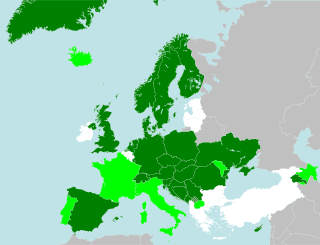
The European Charter for Regional or Minority Languages (ECRML) is a European treaty adopted in 1992 under the auspices of the Council of Europe to protect and promote historical regional and minority languages in Europe. However, the charter does not provide any criterion or definition for an idiom to be a minority or a regional language, and the classification stays in the hands of the national state.

The European Union created a Committee of the Regions to represent Regions of Europe as the layer of EU government administration directly below the nation-state level. The committee has its headquarters in Brussels.
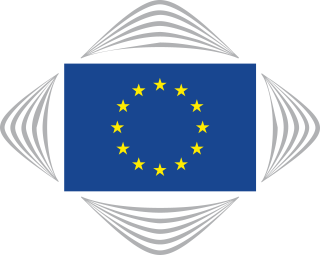
The European Committee of the Regions (CoR) is the European Union's (EU) assembly of local and regional representatives that provides sub-national authorities with a direct voice within the EU's institutional framework.
In European politics, the term Euroregion usually refers to a transnational co-operation structure between two contiguous territories located in different European countries. Euroregions represent a specific type of cross-border region.

The European Structural and Investment Funds are financial tools set up to implement the regional policy of the European Union. They aim to reduce regional disparities in income, wealth and opportunities. Europe's poorer regions receive most of the support, but all European regions are eligible for funding under the policy's various funds and programmes. The current Regional Policy framework is set for a period of seven years, from 2021 to 2027.

The Council of European Municipalities and Regions (CEMR) is the largest organisation of local and regional governments in Europe. Its members are 60 national associations of towns, municipalities and regions from 41 countries that are part of the Council of Europe. Together these associations represent about 130,000 local and regional authorities.
Christopher Newbury is a British Conservative politician. He was a member of the Congress of the Council of Europe from 1998 to 2010 and since 2009 has been a member of the new Wiltshire Council created that year.
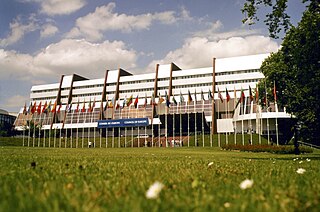
The Congress of Local and Regional Authorities is the pan-European political assembly representing local and regional authorities from the forty-seven member states of the Council of Europe. Its role is to promote local and regional democracy, improve local and regional governance and strengthen authorities' self-government, according to the principles laid down in the European Charter of Local Self-Government. It is made up of two chambers, the Chamber of Local Authorities and the Chamber of Regions and holds its plenary sessions twice a year at the Palace of Europe in Strasbourg, where its permanent Secretariat is located.

Anti-Romani sentiment is hostility, prejudice, discrimination or racism which is specifically directed at Romani people. Non-Romani itinerant groups in Europe such as the Yenish, Irish and Highland Travellers are often given the misnomer "gypsy" and confused with the Romani people. As a result, sentiments which were originally directed at the Romani people are also directed at other traveler groups and they are often referred to as "antigypsy" sentiments.
Pavee Point (PP) is a government-funded non-governmental organisation based in Dublin, Ireland that was formed to improve the human rights of Irish Travellers and to bridge the economic and social inequalities between Travellers and settled people. Irish Travellers are an ethnic minority group that originated from nomadic tradespeople.
The Chamber of Local Authorities is one of the two Chambers of the Congress of Local and Regional Authorities of the Council of Europe. The Chamber is the voice of local authorities in the Council of Europe. It consists of 324 representatives from the Council's 47 member states, who either hold a general local authority mandate from direct elections or are politically accountable to a directly elected assembly. The Chamber provides an opportunity for local officials to discuss common concerns, share their experiences and develop relevant policies.
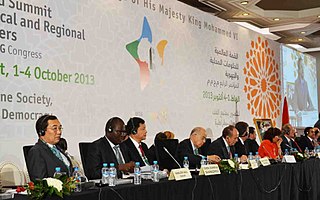
United Cities and Local Governments (UCLG) is an umbrella international organisation for cities, local and regional governments, and municipal associations throughout the world that is concerned with representing and defending the interests of local governments on the world stage.
The North–South Centre, officially the European Centre for Global Interdependence and Solidarity, is a Partial Agreement — of the Council of Europe, the oldest political organisation of European states.

The INGO Conference is the body representing civil society in the Council of Europe, a European organisation founded in 1949. The Council of Europe has 47 member States with some 800 million citizens and its seat is in Strasbourg, France. The current president is Anna Rurka.
The Chamber of Regions is one of the two Chambers of the Congress of Local and Regional Authorities of the Council of Europe, the other being the Chamber of Local Authorities.
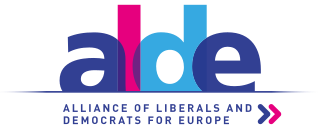
The Alliance of Liberals and Democrats for Europe in the Parliamentary Assembly of the Council of Europe (ALDE-PACE) is a political group in the Parliamentary Assembly of the Council of Europe bringing together 92 members from 26 states. Since January 2020, the group is chaired by Jacques Maire of France.
Dosta! a Romani and Serbo-Croatian word meaning "enough", is a Council of Europe awareness raising campaign which aims to bring non-Roma closer to Roma citizens by breaking down the barriers caused by prejudices and stereotypes.

Andreas Kiefer is an Austrian politician. Since 2010, he is Secretary General of the Congress of Local and Regional Authorities of the Council of Europe, an institution representing local and regional authorities of the 47 member states of the Council of Europe.
The World Forum for Democracy is a gathering each November in Strasbourg, France to debate the complex challenges facing democracies today and foster democratic innovation. The Forum is hosted by the Council of Europe and brings together members of civil society, political leaders and representatives of business, academia, media and professional groups. Past editions have revolved around themes such as "Bridging the gap: democracy between old models and new realities", "Re-wiring Democracy: connecting institutions and citizens in the digital age" and "From participation to influence: can youth revitalise democracy?".











